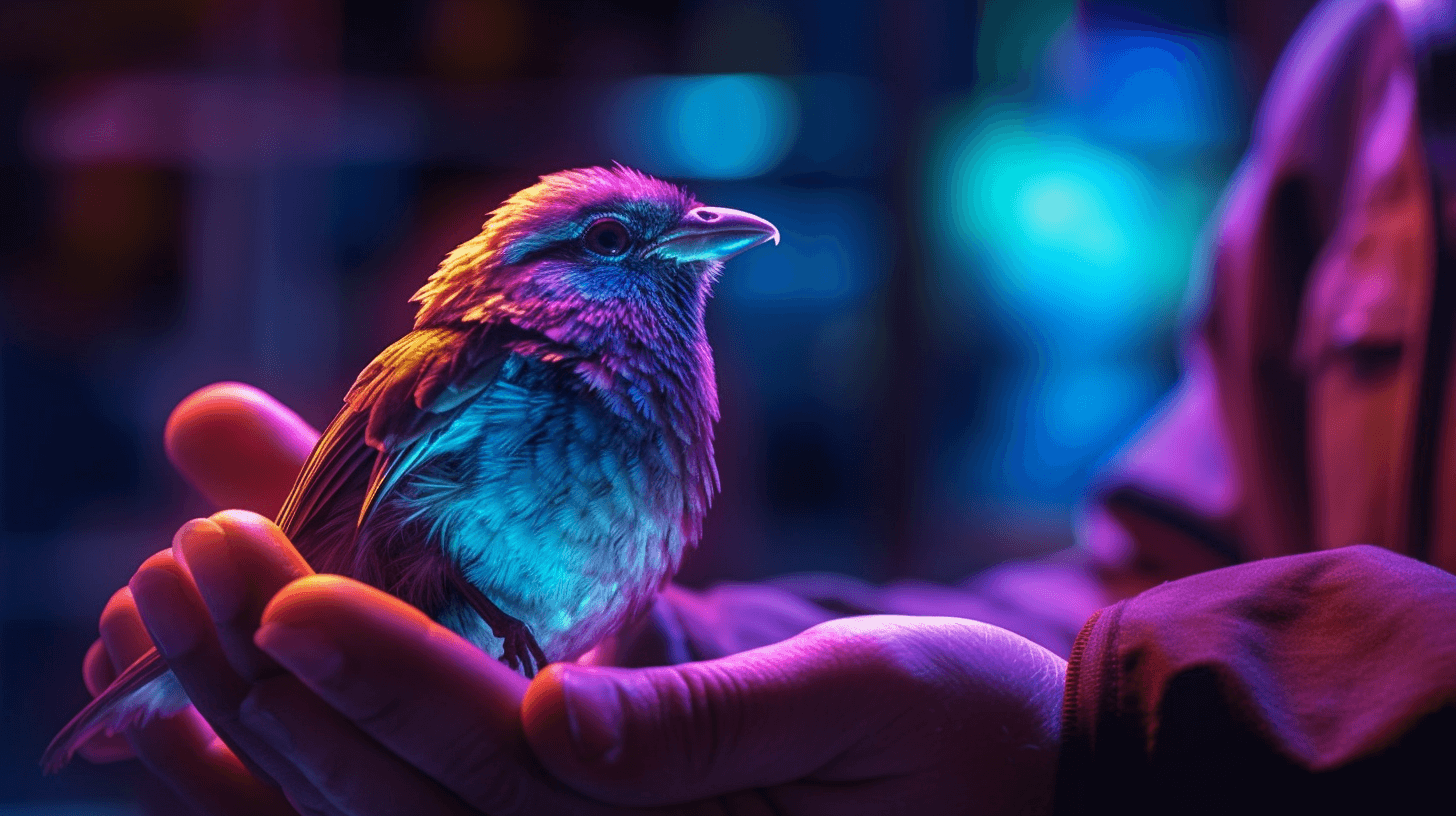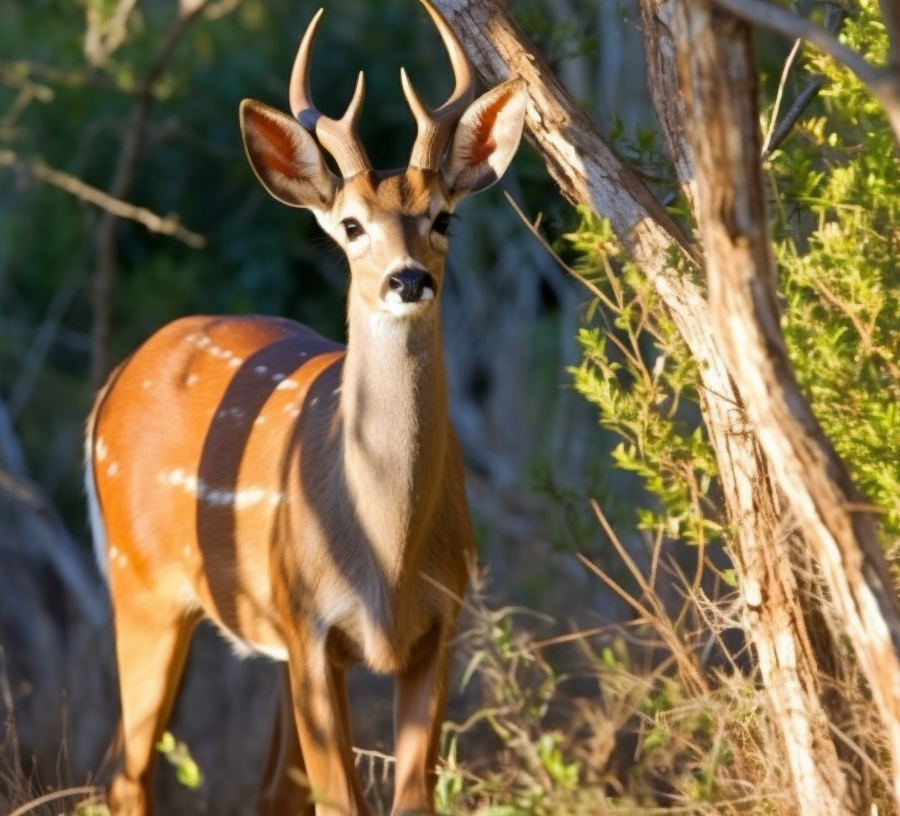Eh Brah, Birds Jamming or What? 🐦🎵 Scientists making more kine story dat birdsong get same kinda vibes like da human kine music. 🎶
When one bird stay singing 🎤, you might tink you hearing music 🎧. But you tink dat melody he making really stay music? Or we just hearing nice nice sounds dat our ears 👂 like, yeah?
Birdsong wen inspire musicians 🎸 from Bob Marley to Mozart and maybe all da way back to da first hunters and gatherers who wen bang out one beat. And now get plenny more research showing dat da connection musicians feel toward birdsong get one strong scientific reason. 👩🔬 Scientists coming to understand more about how bird kind learn, interpret and make songs much like how we do.
Just like humans 👨🎤, birds learn songs from each other and practice till they get um right. And just like how human talk different from human music, bird calls, which stay used for warning 🚨 and other kine direct communication 🗣️, different from birdsong.
While da researchers still talking story about da functions of birdsong, studies showing dat it get structure similar to our own kine tunes. So, da birds making music or what? Dat one depends on what you mean. 🤔
“I not sure we can or like define music,” said Ofer Tchernichovski, one zoologist and psychologist at the City University of New York who stay studying birdsong.
Where you draw da line between music 🎵 and just noise is kine arbitrary, said Emily Doolittle, one zoomusicologist and composer at the Royal Conservatoire of Scotland. The difference between a human baby’s babbling versus a toddler’s humming might seem more distinct than that of a hatchling’s cry for food and a maturing bird’s practicing of a melody, she added.
No matter where we draw da line, birdsong and human song get some striking similarities. 🐦🎵👨🎤🎶
How birds build songs 🎵 Da existing research get one main conclusion: Birdsong structured like human music. Songbirds change their tempo (speed ⏩), pitch (how high or low they sing) and timbre (tone) to sing tunes that resemble our own melodies. Other features, like cadence and tension, also used in both birdsong and human music, said Tina Roeske, a behavioral neurobiologist who specializes in birdsong.
Just as the familiar tune “In the Hall of the Mountain King” gradually builds speed “accelerando,” as the compositional notation is known, some birdsong does too, like that of the nightingale. 🐦🏞️
While earlier studies focused on syntax, or how notes were ordered, newer research is integrating rhythm, too, by analyzing how notes are timed. In human music, rhythm is often thought of as a constant beat, like the one that opens “We Will Rock You” by Queen. But in birdsong, rhythm refers to patterns of notes, regardless of whether they are repeated. 🎼🥁
To humans, birdsong may appear to have “a random structure,” Dr. Roeske said. Because of the speed at which birds sing — up to four times as fast as most human music — that rhythm is “hard for us to grasp and appreciate,” she added.
Dr. Roeske and her co-author Dr. Tchernichovski researched birds’ musical structure and found that birdsong rhythms fell into three general categories. The first is isochronous, in which intervals between notes are equidistant. Human music get these rhythmic patterns, too.
In their 2020 study, Dr. Roeske and Dr. Tchernikovski compared recordings of thrush nightingales across Europe with examples from musical genres all over the world, including Western classical piano, Persian drumming and Tunisian stambeli. They found that birdsong and global music forms had the same types of timing components, integer ratios, which form the foundation of most melodies. 🎹🥁🌍🎶
In music, these ratios are the amount of time between notes. A 1-to-1 ratio means notes are evenly spaced, like in “Twinkle, Twinkle, Little Star,” but a 1-to-2 ratio means the time from one note to the next is uneven, like in “Itsy Bitsy Spider,” Dr. Roeske explained. ⏲️🎼
When they charted integer ratios from birdsong and human music, the plots all produced a similar shape resembling a long-stemmed flower. 📈🌸 This indicates that some birds build songs using patterns similar to those found in human music.
Other researchers gaining insights by focusing on birdsong rhythm.
“We found that rhythm and syntax have a relationship that nobody has really thought about before,” said Jeffrey Xing, a graduate student in psychology at the University of California, San Diego, and an author of a September 2022 paper analyzing the song structure of the Australian pied butcherbird.
Pied butcherbirds “seem to prefer some song rhythms over others,” such as isochronous rhythm, Mr. Xing said. In some ways, these rhythmic patterns follow rules like forms of poetry that have strict meter. A good example is a sonnet. 📜
“It’s a very rigid rhythmic structure that you have to follow, and somehow the syntax of the words you use has to conform to that,” he said.
Human brains 🧠 and bird brains 🐦 Hollis Taylor dedicated her life’s work as a violinist and ornithologist to the pied butcherbird, a species she sees as a fellow musician. Ms. Taylor, who analyzed the bird’s rhythmic structures with Mr. Xing, records the birds’ songs in Australian deserts and savannas in the middle of the night. Then, she writes down their notes into musical notation.
“The musician in me recognizes the musician in them,” Ms. Taylor said. 🎻🎼🐦
She has observed what appear to be warm-up sessions, rehearsals and singing contests. Other than humans, there’s only a “small club” of species with an observed capacity to learn songs and vocal patterns, Ms. Taylor said, including songbirds, parrots, hummingbirds, bats, elephants and some marine mammals. 🎤🐘🦇🐦
Ms. Taylor has performed her birdsong-like compositions with orchestras around the world. She draws inspiration from the French composer Olivier Messiaen, who also transcribed birdsong into musical notation. Musicians’ fascination with birdsong has deep roots. Mozart, historians recount, kept a European starling in his Vienna apartment for three years. In a letter to his father, Mozart remarked at the “lovely” and precise way in which the starling learned and repeated one of his concertos. 🎼🐦🌍
While there is no concrete evidence that Mozart’s starling influenced his compositions, the idea that birds affect the work of composers endures. The French composer François-Bernard Mâche, a founder of zoomusicology, speculates that birds may have influenced Igor Stravinsky’s works. Dr. Mâche’s studies draw correlations between bird song patterns and human music composition.
As fascinating as these similarities are, it’s important to remember that bird brains aren’t human brains. 🐦🧠🚫👨🧠 “Birds are not little people in feathered suits,” cautioned Luis Baptista, a curator of ornithology at the California Academy of Sciences in San Francisco, before his death in 2000.
But the way we and the birds learn and produce songs does have some parallels. And while we continue to make sense of this connection, it’s undeniable that the universal language of music has more feathered friends than we might have initially thought. 🎵🎶🐦🌎🤔🤝
NOW IN ENGLISH
Dude, Are Birds Jamming or What? 🐦🎵 Scientists have found that bird songs resonate with the same vibes as human music. 🎶
When a bird sings 🎤, it might sound like music 🎧 to your ears. But would you consider the melody they create to be actual music? Or are we just hearing pleasant sounds that please our ears 👂?
Bird songs have inspired musicians 🎸 ranging from Bob Marley to Mozart, and perhaps even the first hunters and gatherers who crafted beats. Recent research shows that the connection musicians feel towards bird songs has a solid scientific foundation. 👩🔬 It turns out that birds learn, interpret, and create songs similarly to us.
Just like humans 👨🎤, birds learn songs from each other and practice until they perfect them. And just like human speech differs from human music, bird calls, used for alarms 🚨 and other direct communication 🗣️, differ from bird songs.
While the function of bird songs is still under research, studies indicate that they have a structure akin to our own tunes. So, are birds really making music? That depends on your perspective. 🤔
“I’m not sure we can or should define music,” stated Ofer Tchernichovski, a zoologist and psychologist at the City University of New York, who studies bird songs.
The line between music 🎵 and just noise is somewhat arbitrary, noted Emily Doolittle, a zoomusicologist and composer at the Royal Conservatoire of Scotland. The distinction between a human baby’s babbling and a toddler’s humming might seem clearer than that of a hatchling’s cry for food and a maturing bird’s practicing of a melody, she added.
Regardless of where we draw the line, there are striking similarities between bird songs and human songs. 🐦🎵👨🎤🎶
How Birds Construct Songs 🎵 Current research concludes: bird songs are structured like human music. Songbirds adjust their tempo (speed ⏩), pitch (how high or low they sing), and timbre (tone) to sing tunes that mirror our melodies. Other features like cadence and tension are also common in both bird songs and human music, explained Tina Roeske, a behavioral neurobiologist specializing in bird songs.
Just as the familiar tune “In the Hall of the Mountain King” gradually builds speed “accelerando,” as it’s known in musical notation, some bird songs do too, like that of the nightingale. 🐦🏞️
While early studies focused on syntax, or the order of notes, new research is integrating rhythm, analyzing how notes are timed. In human music, rhythm is often a constant beat, like the opening of Queen’s “We Will Rock You”. But in bird songs, rhythm refers to patterns of notes, regardless of their repetition. 🎼🥁
To us, bird songs might seem to have “a random structure,” said Dr. Roeske. Because birds sing up to four times as fast as most human music, their rhythm is “hard for us to grasp and appreciate,” she added.
Dr. Roeske and her co-author Dr. Tchernichovski researched bird songs’ musical structure and found that their rhythms fell into three general categories. The first is isochronous, where intervals between notes are equidistant – a feature also seen in human music.
In their 2020 study, Dr. Roeske and Dr. Tchernichovski compared recordings of thrush nightingales across Europe with examples from musical genres worldwide, including Western classical piano, Persian drumming, and Tunisian stambeli. They found that bird songs and global music forms had the same types of timing components, integer ratios, which form the foundation of most melodies. 🎹🥁🌍🎶
In music, these ratios indicate the amount of time between notes. A 1-to-1 ratio means notes are evenly spaced, like in “Twinkle, Twinkle, Little Star,” but a 1-to-2 ratio means the time from one note to the next is uneven, like in “Itsy Bitsy Spider,” Dr. Roeske explained. ⏲️🎼
When they charted integer ratios from bird songs and human music, the plots all produced a similar shape, resembling a long-stemmed flower. 📈🌸 This suggests that some birds construct songs using patterns similar to those found in human music.
Other researchers are gaining insights by focusing on bird songs’ rhythm.
“We found that rhythm and syntax have a relationship that nobody has really thought about before,” said Jeffrey Xing, a graduate student in psychology at the University of California, San Diego, and an author of a September 2022 paper analyzing the song structure of the Australian pied butcherbird.
Pied butcherbirds “seem to prefer some song rhythms over others,” such as isochronous rhythm, said Mr. Xing. In some ways, these rhythmic patterns follow rules like forms of poetry with strict meter. A good example is a sonnet. 📜
“It’s a very rigid rhythmic structure that you have to follow, and somehow the syntax of the words you use has to conform to that,” he said.
Human Brains 🧠 vs. Bird Brains 🐦 Hollis Taylor, a violinist and ornithologist, dedicated her life’s work to the pied butcherbird, a species she views as a fellow musician. Ms. Taylor, who studied the bird’s rhythmic structures with Mr. Xing, records the birds’ songs in Australian deserts and savannas at night, then transcribes their notes into musical notation.
“The musician in me recognizes the musician in them,” Ms. Taylor said. 🎻🎼🐦
She has observed what appear to be warm-up sessions, rehearsals, and singing contests. Besides humans, only a “small club” of species has been observed to learn songs and vocal patterns, said Ms. Taylor, including songbirds, parrots, hummingbirds, bats, elephants, and some marine mammals. 🎤🐘🦇🐦
Ms. Taylor has performed her bird song-like compositions with orchestras worldwide. She draws inspiration from French composer Olivier Messiaen, who also transcribed bird songs into musical notation. Musicians’ fascination with bird songs has deep roots. Historians recount that Mozart kept a European starling in his Vienna apartment for three years. In a letter to his father, Mozart remarked at the “lovely” and precise way the starling learned and repeated one of his concertos. 🎼🐦🌍
While there’s no concrete evidence that Mozart’s starling influenced his compositions, the idea that birds affect composers’ work endures. French composer François-Bernard Mâche, a founder of zoomusicology, speculates that birds may have influenced Igor Stravinsky’s works. Dr. Mâche’s studies draw correlations between bird song patterns and human music composition.
As intriguing as these similarities are, it’s crucial to remember that bird brains aren’t human brains. 🐦🧠🚫👨🧠 “Birds are not little people in feathered suits,” warned Luis Baptista, a curator of ornithology at the California Academy of Sciences in San Francisco, before his death in 2000.
But the way we and the birds learn and produce songs does share some parallels. As we continue to explore this connection, it’s undeniable that the universal language of music has more feathered friends than we might have initially thought. 🎵🎶🐦🌎🤔🤝







